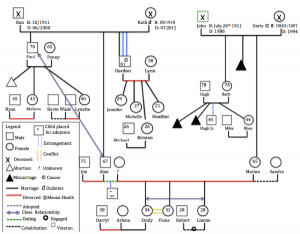School psychologists are able to work collaboratively with parents in order to engage them in the decision making process about their child. They are able to navigate cultural and linguistic differences with respect, promoting strategies for effective parenting.
EDPS 660 – Social, Emotional and Behavioral Assessment
Through this course I gained practice and experience in recognizing the ethical, legal and professional responsibilities inherent in the psychological assessment process. I read literature and listened to lectured on identifying socio-cultural, contextual, risk, and protective factors that impact a child’s functioning. I was able to develop proficiency in the use of semi-structured clinical interviews and behavioral observation techniques through practice assignments.
EDPS 650 – Family and Social Bases of Behaviour
EDPS 674 – Interventions to Promote Socio-Emotional and Behavioural Well-Being
Degnan, K., Almas, A., & Fox, N. (2010) Temperament and the environment in the etiology of childhood anxiety. Journal of Child Psychology and Psychiatry 51(4). p 497–517 doi:10.1111/j.1469-7610.2010.02228.x
Summary
Anxiety disorders are prevalent throughout childhood and adolescence. As such, identifying the factors and mechanisms that precede and maintain anxiety disorders is essential for the development of empirically based prevention and intervention programs. This review focuses on child temperament and the child’s environment, including parenting, childcare, and peer relationships, as these factors have been linked to internalizing problems and anxiety diagnoses.
How it as informed practice
There are many parenting styles that maintain behavioural inhibition as behavioral inhibition is a temperament that has been described in early childhood and is asso- ciated with risk for anxiety disorders. It is important to be aware of the effective parenting styles outlined in this article. It is, of course important that these concerns of ineffective parenting styles are communicated in an effective way and once rapport has been built.
Resource
Maccoby, E. E. (2014). Historical overview of socialization research and theory. In J. E. Grusec, & P. D. Hastings (Eds.), Handbook of Socialization: Theory and research (pp. 3-32). New York: The Guilford Press
Summary
This chapter describes a historical perspective of socialization wherein the family is the major influence on teaching the skills the child needs to grow up in that particular culture.
How it as informed practice
It is important to remain in tune with the many positive impacts parents have on the socialization of their children but it is also important to be aware of the negative socialization that can sometimes occur as well. Things like a maladaptive thinking strategy can be passed down through family systems. Parent-child communication and developmental changes in parent-child interactions are just a few examples of the dynamic of the parent-child relationship affection socialization of the child.
Resource
Wentzel, K. R.. (2014). Socialization in school settings. In J. E., Grusec, & P. D. Hastings (Eds.), Handbook of socialization: Theory and research (pp. 251-275). New York: The Guilford Press.
Summary
The extant literature on the social functioning of students with learning disabilities (LD) has indicated that whereas a major- ity belong to peer groups, a higher proportion are isolated and most have lower social status among peers in general than their typically achieving classmates.
How it as informed practice
This informs my practice because it is important to assess social/emotional outcomes for those students who are struggling academically, in particular, older children as they become increasingly self-aware. The literature on the social functioning of students with learning disabilities has indicated that whereas a majority belong to peer groups, a higher proportion are isolated and most have lower social status among peers in general than their typically achieving classmates.
